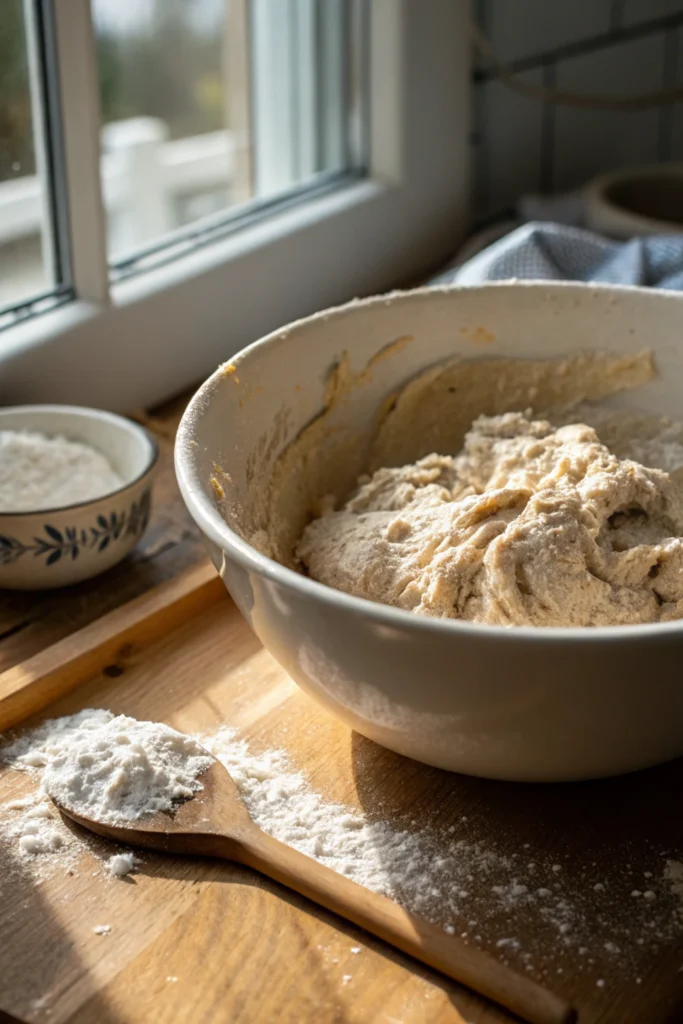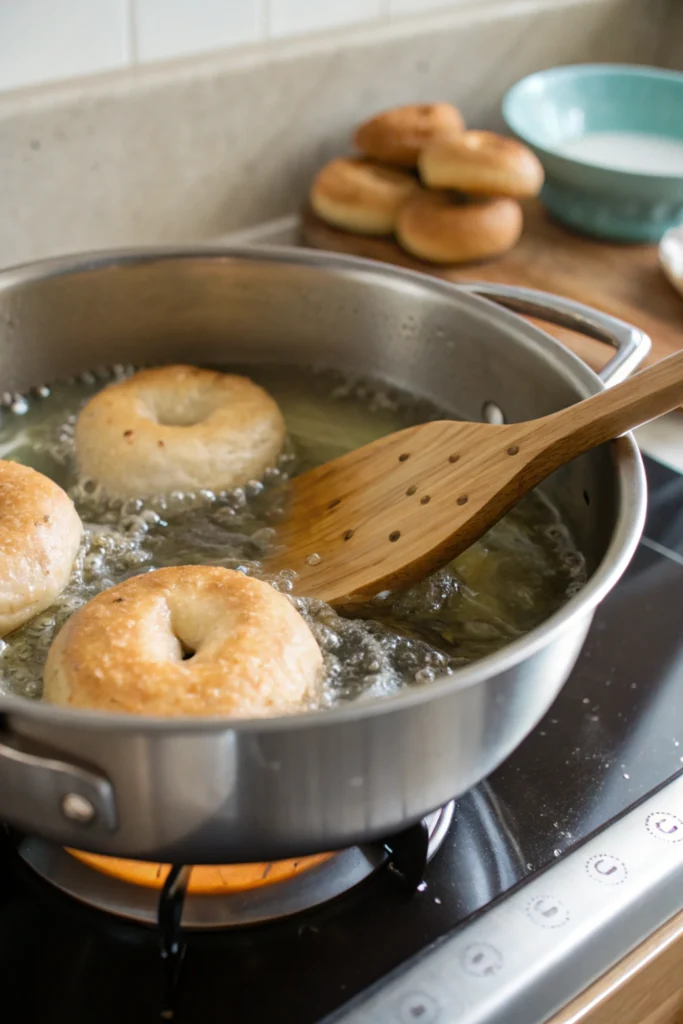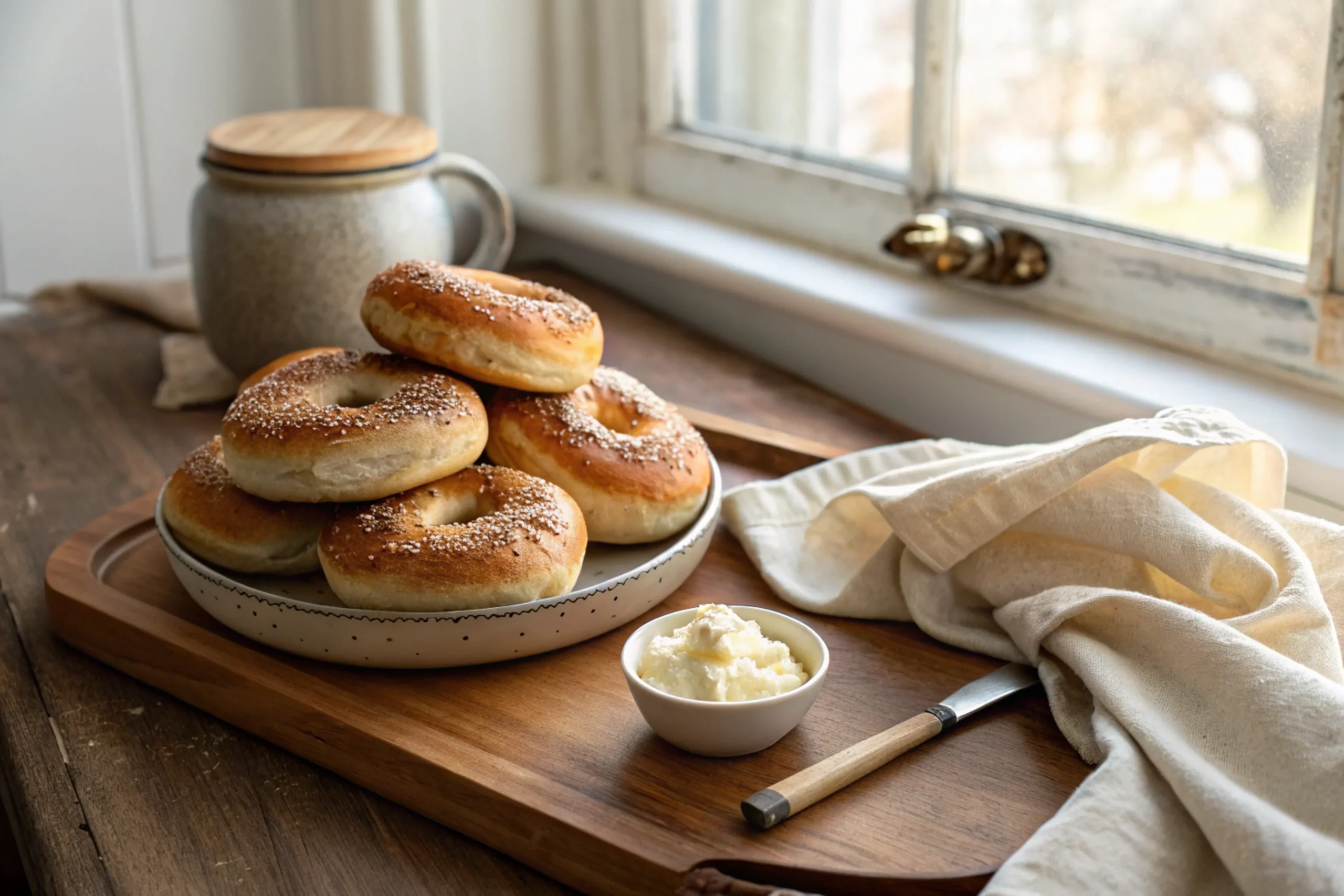Imagine sinking your teeth into a warm, chewy bagel with a crispy crust, a hint of tangy sourdough flavor, and the satisfaction of knowing you made it yourself—using something you might have thrown away! If you’ve been nurturing a sourdough starter, you’ve likely faced the dilemma of what to do with all that sourdough discard. Well, here’s your answer: transform it into perfect bagels that rival any bakery’s offerings. Not only does this save waste, but it also adds a unique, tangy twist to your bagels, making them a breakfast (or anytime) staple.
In this guide, we’ll take you through everything you need to know to master sourdough discard bagels. From understanding what sourdough discard is to choosing the right ingredients, following a foolproof recipe, and exploring creative variations, we’ve got you covered. Plus, we’ll answer your burning questions, share expert tips, and even throw in a few surprises—like how to pair your bagels with the perfect spread. Ready to roll up your sleeves and get baking? Let’s dive in!
Table of Contents
Understanding Sourdough Discard
What Is Sourdough Discard?
If you’re a sourdough enthusiast, you know the routine: you feed your starter, it bubbles and grows, and then you discard a portion to keep it healthy. That portion you remove? That’s sourdough discard. It’s essentially inactive starter—equal parts flour and water that have already risen and fallen, losing their peak leavening power. But here’s the kicker: it’s still packed with flavor, thanks to the lactic acid bacteria that give sourdough its signature tang.
Why Use Sourdough Discard in Bagels?
Using sourdough discard in bagels is a win-win. First, it reduces kitchen waste, which is a big deal—did you know that food waste accounts for nearly 30% of household trash, according to the EPA? Second, it adds a unique, tangy flavor to your bagels, setting them apart from the store-bought kind. And third, it’s incredibly versatile. Not convinced? Check out other creative ways to use discard, like in our delicious sourdough scones or sourdough French toast.
How to Store and Maintain Your Discard
To make the most of your sourdough discard bagels, store it in an airtight container in the fridge. It’s best used within a week, though some bakers stretch it to two if it smells fine (no funky odors, please!). If you’re not ready to bake, you can freeze it in portions—think ice cube trays for easy measuring. Just remember to thaw it in the fridge before using.
The Science Behind Sourdough Bagels
How Sourdough Discard Bagels Affects Flavor and Texture
Here’s where things get nerdy (and delicious). Sourdough discard Bagels isn’t just a waste product; it’s a flavor powerhouse. The bacteria in your starter produce lactic acid, which gives bagels that tangy, complex taste. But because discard has already risen and fallen, it’s not as active as a freshly fed starter, meaning it might not provide enough lift on its own. That’s why many recipes, including ours, use a touch of commercial yeast to ensure those chewy bagels rise properly.
“Sourdough discard adds a unique tang that elevates bagels, but don’t expect it to do the heavy lifting—yeast is your friend here.”
Expert Baker, Sourdough Magazine
Comparing Discard vs. Active Starter
Wondering how discard bagels differ from those made with active starter? Here’s a quick breakdown:
| Aspect | Sourdough Discard Bagels | Active Starter Bagels |
|---|---|---|
| Rise Time | Faster (with yeast, 2 hours) | Slower (8-12 hours) |
| Flavor | Tangy, but milder | Stronger, more complex |
| Texture | Potentially denser | Lighter, airier |
| Ease | Easier for beginners | Requires planning |
The Role of Fermentation
Even with discard, fermentation plays a role. The longer you let your dough rest, the more pronounced the sourdough flavor becomes. Some bakers even recommend an overnight ferment in the fridge for maximum tang—perfect if you’re a flavor fanatic.
Choosing the Right Ingredients
Flour: The Foundation of Chewy Bagels
The type of flour you use is crucial for that signature chewy texture. Here’s a quick guide:
| Flour Type | Impact on Texture | Best For |
|---|---|---|
| All-Purpose | Soft, tender | Beginners |
| Bread Flour | Chewy, dense | Traditional bagels |
| Whole Wheat | Hearty, denser | Health-focused |
For the best results, we recommend bread flour—its high protein content (around 12-14%) creates that perfect chew. If you’re feeling adventurous, mix in a little whole wheat flour for a nutty flavor, but keep it to 25% of the total to avoid a brick-like bagel.
Water, Yeast, and Additives
- Water: Use warm water (around 100°F) to activate the yeast. Too hot, and you’ll kill it; too cold, and your rise will be sluggish.
- Yeast: A small amount of instant or active dry yeast ensures a reliable rise, especially with discard. If you’re yeast-averse, you can skip it, but expect a denser bagel and a longer rise time (more on that in the FAQs).
- Salt and Sugar: Salt enhances flavor, while a touch of sugar feeds the yeast and helps with browning. Some recipes add malt syrup to the boiling water for that classic bagel sheen—check out King Arthur Baking for more on this technique.
Step-by-Step Guide to Making Sourdough Discard Bagels
Ready to get your hands doughy? Here’s our foolproof recipe for sourdough discard bagels, yielding 8 large or 10 smaller bagels.
Ingredients
- 3 ¾ cups bread flour (450g)
- 1 cup sourdough discard (240g)
- ¾ cup warm water (180ml, 100°F)
- 1 tablespoon sugar
- 1 ½ teaspoons salt
- 1 teaspoon instant yeast
- For boiling: 1 tablespoon baking soda
- Optional: Egg wash (1 egg beaten with 1 tablespoon water) for shine
Instructions

- Mix the Dough: In a large bowl, combine bread flour, sugar, salt, and yeast. Add sourdough discard and warm water, mixing until a shaggy dough forms. Knead on a lightly floured surface for about 10 minutes, until smooth and elastic. The dough should be stiff but not dry—add water or flour a teaspoon at a time if needed.
- First Rise: Place the dough in a lightly oiled bowl, cover with a damp towel, and let rise in a warm place for 1-2 hours, or until doubled in size. (Pro tip: If it’s chilly, pop the bowl in an off oven with the light on for warmth.)
- Shape the Bagels: Punch down the dough and divide into 8 equal pieces (or 10 for smaller bagels). Roll each piece into a ball, then poke a hole in the center with your finger. Stretch the hole to about 2 inches wide—it’ll shrink during boiling. Place shaped bagels on a parchment-lined baking sheet, cover, and let rest for 20 minutes.
- Boil the Bagels: Bring a large pot of water to a boil, add baking soda, and reduce to a simmer. Boil each bagel for 30 seconds per side, then return to the baking sheet. This step sets the crust and gives bagels their signature chew.
- Bake: Preheat your oven to 425°F (220°C). Brush bagels with egg wash for shine, if desired, and add toppings (see variations below). Bake for 20-25 minutes, or until golden brown. Cool on a wire rack.


Troubleshooting and Tips for Perfect Bagels
Even the best bakers hit snags, so here are some common issues and fixes:
- Dough Too Sticky: Add flour a tablespoon at a time, but don’t overdo it—bagel dough should be stiff.
- Bagels Not Rising: Ensure your yeast is fresh and your rising spot is warm. If using discard without yeast, expect a slower rise (up to 8 hours).
- Bagels Too Dense: Don’t skip the boiling step—it’s crucial for texture. Also, avoid over-kneading, which can toughen the dough.
- Uneven Shapes: Stretch the holes wider than you think—they shrink during boiling. For uniformity, weigh your dough balls (about 100g each for 8 bagels).
Flavor Variations and Toppings
Classic Toppings
Take your sourdough discard bagels to the next level with these toppings, applied before baking:
- Everything Bagel Seasoning: A mix of sesame seeds, poppy seeds, dried garlic, onion, and salt—perfect for savory lovers.
- Sesame or Poppy Seeds: Classic and simple, great for sandwiches.
- Coarse Salt: For a pretzel-like vibe.
Sweet Options
Craving something sweeter? Try these:
- Cinnamon Sugar: Brush with melted butter and sprinkle with cinnamon sugar before baking.
- Blueberry: Add ½ cup dried blueberries to the dough during mixing.
- Chocolate: Mix in ½ cup mini chocolate chips for a decadent treat.
Savory Twists
For a savory kick, consider:
- Jalapeño Cheddar: Add ½ cup shredded cheddar and 2 tablespoons diced jalapeños to the dough.
- Herb and Garlic: Mix in 1 tablespoon dried herbs (like rosemary) and 1 teaspoon garlic powder.
Stuffed Bagels
Want to get fancy? Stuff your bagels with cream cheese or other fillings. After shaping, flatten each dough ball, add a tablespoon of filling, then reshape and seal tightly. Boil and bake as usual.

Storing and Preserving Your Bagels
Storing Fresh Bagels
To keep your sourdough discard bagels fresh, store them in a brown paper bag at room temperature. They’ll stay good for 4-5 days, though they’re best within the first two.
Freezing for Later
For longer storage, wrap each bagel individually in plastic wrap, then place in a freezer bag. They’ll keep for up to 3 months. To enjoy, thaw at room temperature or pop in the oven at 350°F for 5-10 minutes to revive that crust.
Reheating Tips
Reheat day-old bagels by slicing and toasting, or warm in the microwave for 15 seconds for a quick fix. Avoid plastic bags for storage—they trap moisture and make bagels soggy.
A Unique Angle: Pairing Bagels with Spreads
Here’s something you won’t find in most sourdough bagel recipes: pairing ideas to elevate your bagel experience. The tangy flavor of discard bagels pairs beautifully with a variety of spreads. Here’s a table to inspire you:
| Bagel Type | Best Spread Pairing | Why It Works |
|---|---|---|
| Plain | Honey Cream Cheese | Sweetness balances tanginess |
| Everything | Avocado Spread | Creamy avocado cuts through saltiness |
| Cinnamon Sugar | Apple Butter | Warm spices enhance sweetness |
| Jalapeño Cheddar | Spicy Hummus | Heat meets heat for a bold bite |
Conclusion
There you have it—a complete guide to making perfect sourdough discard bagels that are chewy, flavorful, and oh-so-satisfying. By using sourdough discard, you’re not just baking; you’re reducing waste, experimenting with flavors, and creating something truly special. Whether you stick to the classic recipe or venture into stuffed bagels and wild toppings, the possibilities are endless.
Ready to take your sourdough skills to the next level? Sign up for our free e-book, “10 Creative Ways to Use Sourdough Discard,” and unlock even more delicious ideas. And don’t forget to share your bagel creations in the comments below—we’d love to hear your tips and tricks!
FAQs: Answering Your Most Common Questions
What Is Sourdough Discard?
Sourdough discard is the portion of your starter you remove before feeding. It’s still full of flavor but lacks the leavening power of an active starter, making it perfect for recipes like bagels.
Can I Make Bagels Without Commercial Yeast?
Yes, but expect a slower rise (up to 8 hours or more) and a denser texture. For best results, especially with discard, a small amount of yeast is recommended.
How Does Sourdough Discard Affect Taste?
It adds a tangy, complex flavor, thanks to the lactic acid bacteria in the starter. The longer you ferment the dough, the stronger the tang.
What’s the Difference Between Discard and Active Starter Bagels?
Discard bagels are faster and easier, often using yeast, while active starter bagels take longer but offer a lighter texture and stronger flavor. See the comparison table above for details.
How Do I Adjust for High Altitude?
Reduce yeast by 25% and increase rise time slightly. You may also need to add a bit more water to the dough, as high altitudes can dry it out.
Can I Use Different Flours?
Absolutely! Whole wheat flour adds a hearty flavor but makes bagels denser, while rye flour can enhance tanginess. Stick to at least 75% bread flour for the best chew.

Sourdough Discard Bagels
- Total Time: 45 minutes (plus fermentation time)
- Yield: 8 bagels
Description
Got extra sourdough discard? Turn it into deliciously chewy homemade bagels! These sourdough discard bagels reduce kitchen waste while delivering a unique tangy flavor that rivals any bakery. They’re easy to make, and with a touch of yeast, you’ll get that perfect texture without an all-day wait. Perfect for breakfast, brunch, or a quick snack, these bagels are sure to become a household favorite.
Ingredients
For the Dough:
- 3 ¾ cups (450g) bread flour
- 1 cup (240g) sourdough discard
- ¾ cup (180ml) warm water (about 100°F)
- 1 tablespoon sugar
- 1 ½ teaspoons salt
- 1 teaspoon instant yeast
For Boiling:
- 1 tablespoon baking soda
Optional:
- 1 egg, beaten with 1 tablespoon water (for egg wash)
- Toppings: Everything bagel seasoning, sesame seeds, poppy seeds, coarse salt, cinnamon sugar, or shredded cheese
Instructions
1️⃣Mix the Dough:
In a large mixing bowl, whisk together the flour, sugar, salt, and yeast. Add the sourdough discard and warm water. Mix until a shaggy dough forms.
2️⃣ Knead the Dough:
Transfer the dough to a lightly floured surface and knead for about 10 minutes until smooth and elastic. The dough should be stiff but not dry. Add small amounts of water or flour as needed.
3️⃣ First Rise:
Place the dough in a lightly oiled bowl, cover with a damp towel, and let it rise in a warm place for 1-2 hours or until doubled in size.
4️⃣ Shape the Bagels:
Punch down the dough and divide it into 8 equal pieces (or 10 for smaller bagels). Roll each piece into a ball, poke a hole in the center with your finger, and stretch it to about 2 inches wide. Place them on a parchment-lined baking sheet, cover, and let them rest for 20 minutes.
5️⃣ Boil the Bagels:
Bring a large pot of water to a boil and add 1 tablespoon of baking soda. Reduce to a simmer. Boil each bagel for 30 seconds per side, then place them back on the baking sheet.
6️⃣ Add Toppings (Optional):
If using, brush the bagels with the egg wash and sprinkle with your favorite toppings.
7️⃣ Bake:
Preheat the oven to 425°F (220°C). Bake the bagels for 20-25 minutes, until golden brown and crisp. Let them cool on a wire rack before slicing.
- Prep Time: 20 min
- Cook Time: 25 min
- Category: Breakfast
- Cuisine: American
Nutrition
- Calories: 220
- Fat: 1g
- Carbohydrates: 45g
- Protein: 8g

